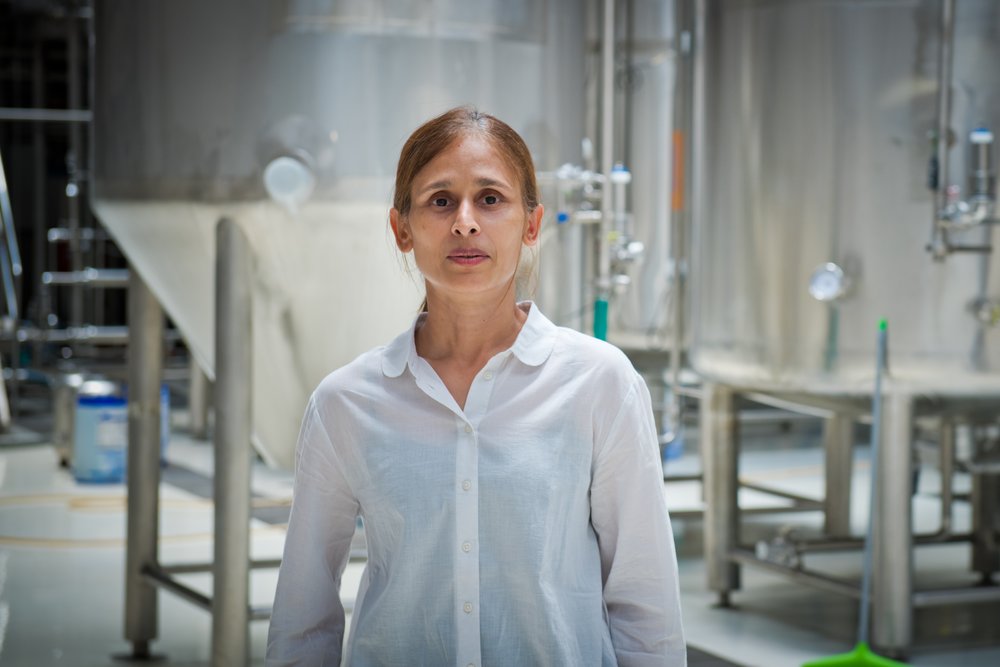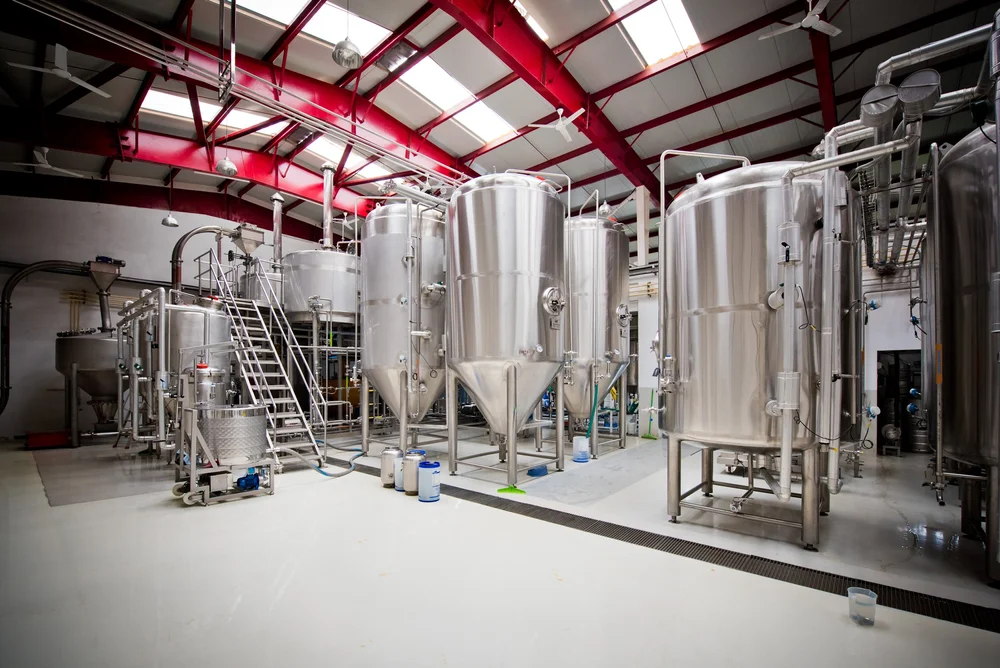
From one point of view, Geist Craft Beer could be just about anywhere. It has the exposed brick walls that denote a placeless hipness, a spacious restaurant, and a sprawling beer garden. It serves a mix of traditional and modern beer styles. Just as at many breweries across Europe and North America, its outdoor spaces are pet-friendly, customers of all species seem to be having a great time, and crowlers are constantly getting filled for takeaway.

Look closer, however, and you’ll begin to notice the small signifiers that set it apart. The 300-year-old tree at the heart of the beer garden is a banyan, the national tree of India. In Oregon or Colorado, a brewery’s leftover malt might be used to make granola, but Geist’s spent grain is turned into the snacks known as nippat and kodubale in Kannada, the main language in the state of Karnataka in southwestern India. (The former is a flat, crunchy disk with flecks of crushed peanuts, curry leaves, and a touch of chili powder for heat, commonly paired with a steaming cup of chai; the latter is like a slim doughnut with a really dense texture, and a popular snack for children.) And the 90 minutes it took us to travel across town to get here means that this must be Bangalore, which frequently ranks first in terms of global traffic congestion.



But Geist is more than a great Bangalore brewery with its own sense of place. As founder Narayan Manepally tells me, it is also one of India’s most tech-savvy beer producers, a zero liquid discharge (ZLD) brewery that uses custom apps and software to keep track of kegs and deliveries.
That’s perhaps not so surprising, considering the location. Once thought of as a sleepy paradise for retirees, Bangalore quickly became known as “the Silicon Valley of Asia” after the liberalization of the Indian economy in 1984, drawing talented people from across the country. Bangalore evolved into a booming IT hub, filled with savvy engineers and entrepreneurs. What they could not find, at least not back then, was good beer.

While imported beer was appreciated by those who could afford it, most people drank just one brand: Kingfisher, commonly known as KF, which locals also call “Uncle’s” in reference to its owner, Vijay Mallya, a legendary businessman and politician currently fighting extradition from the U.K. on charges of financial crimes here in India. For many, KF sufficed—at least until people like Manepally, traveling internationally for work, started discovering craft beer in the U.S. and Europe.
Complex licensing laws made it difficult to establish similar businesses locally, but Bangalore eventually got its first independent brewery in 2011, followed soon after by dozens more. Pre-pandemic, Bangalore had 65 craft breweries—more than any other city in India. And for those of us who live here, Geist has long been a standout.
BROKE AND FIRST BATCHES
Geist’s story begins with Manepally, and the relevant chapter of Manepally’s story started in the late 1980s, during the early days of Bangalore’s IT boom. A newly minted graduate of electrical engineering, he did exactly what most young men at the time were expected to do: he joined the family business, making automotive components. Unfortunately, it didn’t go according to plan.
“My father had this inherent belief that I was incompetent,” he says. “I can’t begrudge him that because I was fresh out of school, trying to make a mark.” Instead of continuing with the family components business, Manepally left the country to join a Masters of Information Systems program at Virginia Tech in the U.S. As a typically broke student, he was down to his last $95 just before graduation. He needed a job, and fast.

“Things were so bad that I would pick up a set of three Kraft Macaroni & Cheese [boxes] for a dollar at the corner store and it was my three meals a day, for many days,” Manepally says with a scowl.
Eventually, he scored a job as an engineer at Intel in Princeton, New Jersey, in 1991. As Intel’s operations grew, Manepally followed the company when offices opened in Portland, Oregon. He spent a lot of time with brilliant engineers, he says, many of whom brewed beer at home.
But Manepally’s first experience with craft beer—Hammerhead IPA at McMenamins’ Cornelius Pass Roadhouse Brewery in Hillsboro—wasn’t entirely positive. As someone who had cut his teeth on KF, he hated its harshness. Instead, the brewery’s fruit Ales slowly won him over.
At work, Manepally bonded with cubicle-mate Jeff Einarson over beer. One Friday afternoon, he joined Einarson for lunch, after which the two spied Main Street Home Brew (now Mainbrew) across the street. They decided to play hooky and check it out.
“I was just fascinated,” says Manepally. “The owner Kevin, a PhD in microbiology from San Diego State University, spoke animatedly about chemical and enzyme reactions in beer-making.”

Armed with $65 of basic brewing equipment, the two brewed a batch of California Golden Ale at Manepally’s home, based on Kevin’s recipe and tips. After a few days of monitoring, it was put in the fridge and forgotten about. A few weeks later, Einarson dropped a bombshell: He’d invited their friends over to try the beer. Terrified it would be undrinkable, Manepally bought backups from a local supermarket.
Those six-packs remained untouched. When the group arrived and Manepally poured the beer, his terror turned to surprise. The color was a deep gold, the head was great, and his first homebrewed beer tasted as good as it looked.
“That was my epiphany,” he says. “I just knew I had to come back to India and pursue craft beer-making.”
THE X+1 SYNDROME
As his years passed in the States, Manepally continued to homebrew, often spending time with brewers to learn more about process, styles, and ingredients. But on every visit back home to India, the only option was KF. That increased his resolve to bring craft beer back to Bangalore, he says. “But I was suffering from the X+1 syndrome, where X is the year you plan to return to your country, but you never get a fix on the year.”
In 2003, however, the decision was made for him: His father-in-law was diagnosed with lung cancer, and Manepally’s wife Gauri moved back to India to look after him. Soon after she left, Manepally realized it was time for him to return home, too.

He soon discovered that hoping to make craft beer in India was a far cry from actually doing it. In the early 2000s, would-be brewers had the Indian market—or rather, the near-complete lack of it—as well as licensing issues, a lack of equipment, consumer education, complex taxation rules, and much more to think about.
“I just wanted to make beer, but there was so much to learn,” he says. “And I say this unabashedly: I made every single mistake there was to make. However, I have this strong belief that if you are passionate enough, go ahead and do it, Mother Nature will make things happen.”


And she did. At his high school reunion in 2004, Manepally met up with classmate Paul Chowdhury, another tech worker with a love for craft beer. Together, they launched the Geist brand on February 2, 2006. Their idea was to create a microbrewery, but while waiting for India’s arcane licensing laws to catch up with them, the two started brewing sample batches in Manepally’s garage. They soon amassed fans, even serving beer in the home of Nandan Nilekani, co-founder of Infosys, one of the world’s largest IT companies, at his birthday celebration in 2005.
With their idea of building a local brewery on hold, their business mentors suggested a “reverse outsourcing” model, brewing Geist beer overseas and bringing the finished product back to India.
I just wanted to make beer, but there was so much to learn. And I say this unabashedly: I made every single mistake there was to make. However, I have this strong belief that if you are passionate enough, go ahead and do it, Mother Nature will make things happen.
Talks with breweries across Germany were unsuccessful, due in part to the lack of capacity to brew the styles they wanted. But in the family-run Brasserie du Bocq in Belgium, they found their partner. Geist produced four initial beers with du Bocq: a Wit, a Belgian Dark Ale, a Blonde Ale, and a Strong Blonde Ale.

“We were the first Indian-origin craft beer, and the first to bring Wheat Beer to India,” he says. “People bought Geist for the stubby bottles we chose and came back for the beer.”
While the team was happy to have beer with their name on local shelves, the local challenges hadn’t faded. Massively fluctuating excise duties forced them to hike retail prices constantly, Manepally says. But outsourcing also taught them the nuances of local sales and distribution through various state warehouses, as well as the value of cold transportation: It broke their hearts, he says, to see their beers degrade in quality due to room-temperature warehouse storage. Whenever Geist’s own brewery saw the light of day, Manepally promised himself that it would have cold-chain operations in place.
FANS AND EMPLOYEES
As Manepally steps out to check on the cold transport trucks that have just backed into the brewery, I seek out Vidya Khuber, Geist’s head brewer. Khuber is notoriously shy when it comes to talking about herself, but she is a respected name on the Indian brewing scene and on the brewing floor, and it’s evident that she runs a tight ship. She has been with the brewery for more than a decade, and first came upon the role by chance.
“I read an article about Geist starting up a brewery,” she says. “I already loved their beers and emailed Narayan with a job application. It was a month before he responded and I interviewed with him and landed the job of brewer.”

That might be an unusual step for a former finance professional, but as a local beer lover, Khuber was one of those customers who kept returning to buy those stubby bottles of Geist’s Wheat Beer at Dewars, a popular liquor store in central Bangalore. A keen world traveler whose itineraries often focused on beer, she had long wanted to get into brewing professionally. Fond of Munich’s beer culture, she found brewers there receptive to her curiosity. After many visits, her knowledge grew until she finally took the plunge, signing up for the Siebel Institute’s World Brewing Academy Master Brewer Program. She joined the Geist team in 2011.
At that time, microbrewery licenses were finally being issued by the government, albeit with some strict requirements. Two of those licenses were received by Bangalore pubs where Manepally was an investor: Brewsky, in the upscale Jayaprakash Nagar residential area, and Big Brewsky (now renamed Byg Brewski Brewing Company), in the Sarjapur neighborhood. The Geist team decided to practice brewing at both locations until they received their own license.


“The demand was phenomenal,” Manepally says. Volumes were far beyond what they expected at a startup brewpub. “But the constant feedback was, ‘Love the beers, hate Bangalore traffic, please make this available closer to where we live.’”
That situation underscored the need to build a centralized brewery capable of real volume. “For this, we needed a brewery and not a microbrewery license, which the Karnataka government was issuing. It was a long process, but we got it in 2016,” Manepally says. Around the same time, Mohan Alapatt, another one of Manepally’s former classmates, joined the Geist team as CEO, helping to locate the brewery’s 11,000 square-foot property.
The Dunkel stood out because there were no other dark craft beers in the market then. Initially, people would opt for [Kingfisher] on weekdays and relax with Geist on weekends, until soon calls began to come in specifically asking for Geist all through the week.
“It was vacant, except for a dilapidated warehouse, and was a mess,” Manepally says. “But when I entered it and saw the banyan tree, I told Mohan, ‘We have to set up here,’ because at some point we were going to have a beer garden.”
After starting construction on its brewery in 2016, Geist was able to ship its first kegs on August 5, 2017.
Until the pandemic, Geist was delivering kegs to over 100 outlets in Bangalore, with a volume of about 340 barrels a month. The current lineup includes Witty Wit, Weiss Guy, and Uncle Dunkel, plus a Märzen, a Rauchbier, a Blonde Ale, an India Pale Lager, and an American-inspired IPA called Kama Citra.

One of Geist’s first outlets was The Local, a pub with a classic “old Bangalore” feel in Kalyan Nagar, a neighborhood in the northeastern part of the city. Owners Sandeep Chandran and Absolom Vijay loved craft beer themselves: The Local was the result of their high-school-era promise to open a bar together, which finally came about after they finished careers in the merchant marine. But they weren’t sure Bangalore was ready for beer styles beyond basic Lagers when they opened the Local in 2014, opting instead for the security of Kingfisher, along with Foster’s and a few specialty beers in bottles.
As tastes changed, however, Chandran and Vijay started looking for other options on draft. Lacking the space required to open their own brewery, they picked Geist, which saw a big increase in interest by 2018, Chandran says. Customers would even call ahead of a visit to make sure their favorite Geist styles were available on tap.
“Geist was a choice that paid off immensely,” he says. “Beginning with the Witty Wit, Weiss Guy, and Uncle Dunkel, the Local saw a steady increase in patrons coming in specifically for Geist. The Dunkel was in demand with calls ensuring its availability coming in almost daily.”


Chandran attributes the popularity of these beers to the fact that they’re all flavorful but still easy-drinking. “Each one is distinct, not too heavy, and very sessionable,” he says. “Despite being in the comfort zone of KF, people were keen to experiment. The Dunkel stood out because there were no other dark craft beers in the market then. Initially, people would opt for KF on weekdays and relax with Geist on weekends, until soon calls began to come in specifically asking for Geist all through the week.” The Local now has a regular group of Geist fans its team calls “the Geist Uncles”: four well-traveled gentlemen in their 70s who have been patrons of the pub since it launched, and who now drink nothing but Geist.
A good share of Geist’s success is due to the market research the brewery performed before launching, according to Akash Hirebet, a beer consultant in Bangalore and the founder of Theka Beverages, a Kuala Lumpur-based beer importer. That helped put craft and international beer styles within reach of local consumers.

“It was a different approach compared to other commercial beers available then,” Hirebet says. “No one sat with bar owners to figure out which beers would work for their customers, but Geist did. For the consumer, craft beer became more accessible since it came to several neighborhood watering holes with Geist.”
THE TECH SIDE
With the keg business growing, plans for the beer garden went forward as Manepally ironed out kinks in the business. To ensure that the cold storage trucks maintained the correct temperature, he worked with Lexlogic, a Bangalore-based company, to develop a custom app for Geist’s vehicles.
“Every keg has a barcode that is scanned as soon as it arrives at the geo-pinned client location,” Manepally says. “This tells us how long the keg takes to go from the back of the truck to the storage at the client’s space.”


When the team realized that some of their bigger customers often didn’t know where their kegs were, Alapatt installed the first enterprise resource planning (ERP) system in an Indian brewery, repurposing and modifying an existing courier ERP to help manage stock, records, as well as many of the brewery’s daily activities. “The system tracks inventory, finances, excise records, and more,” Manepally says. “When our kegs are scanned and dispatched, we know where each one is, what beer it holds, how many days it has been with the customer, etc. If a keg is not returned in 30 days, a little alarm goes off and we nudge our clients. It was a lesson in frustration and excitement in developing, but it was a burden that Alapatt took on enthusiastically.”
In the brewhouse, Khuber explains Geist’s approach to brewing, as well as how the brewery was set up under Chowdhury’s supervision, with guidance from Steve Wagner, the co-founder and original brewmaster of California’s Stone Brewing. While most of the equipment was built in India, the centrifuge and kegging and canning lines were all imported. Today, Geist is able to produce up to 1,065 barrels per month.
It was a different approach compared to other commercial beers available then. No one sat with bar owners to figure out which beers would work for their customers, but Geist did. For the consumer, craft beer became more accessible since it came to several neighborhood watering holes with Geist.
At Geist, Khuber says, stylistic integrity is important, especially when it comes to classic recipes. “We stay within the limits of the style when we first introduce it because we want customers to understand it correctly,” she says. The brewery has tried out 10 styles of beer so far, and eight have become permanent additions to the roster.
In terms of quality, Khuber credits several factors: raw materials, equipment, process, and design. The x-factor is probably Geist’s yeast lab, one of the few such laboratories in a small brewery in India. Manepally says that the yeast lab is the single best investment Geist has made. Khuber says that it is a big part of why she’s stayed at the brewery.


“We do a lot of analyses at the lab to ensure the quality of our beers. Our microbiology team manages the yeast, analyzes it for contamination, and monitors the various parameters of the beer,” she says. “This is done for every beer. We have strains specific to each beer style.”
A new toy for Khuber will be Geist’s pilot brewery, which should come on line in a few months, allowing the team to refine new recipes on a small scale before starting larger production. “This will be our innovation brewery,” she says. “We can be more creative, try processes we always wanted to, and be experimental.”


The first stages of the pandemic and widespread lockdowns might have brought all that to a halt. In November 2020, just as India was recovering from the first wave of infections, Geist was able to open the doors to its new beer garden and restaurant. But then more challenges arrived in the form of the Delta variant and its terrible toll. In response, Bangalore was locked down from early April 2021 through most of May. Geist, like all other hospitality establishments, had to close down in-restaurant dining, while the shuttering of pubs hit the heart of its keg business. Curbs were gradually lifted beginning at the end of June, but pubs were only allowed to reopen in early October. The impact was immense—not only for Geist, but for pubs in general.
It’s heartening, then, to visit today and see Geist now looking busy and full of life. For Manepally, the location is all about introducing customers to the brand. “The beer garden is where you experience all things Geist: food, the beer, the service, and the ambiance,” he says. “You get to know us as people.”
A CIRCULAR ECONOMY
The sprawling beer garden is lined with thick, tall foliage which benefits from Geist’s status as a zero liquid discharge brewery. All the sewage water and kitchen waste are organically treated, Manepally explains, using eco-friendly chemicals and leaves from neem, also known as Indian lilac, and moringa, or drumstick tree. The treatment effectively creates usable water, while the remaining sludge is collected, placed in drying beds, and then composted.



Geist also employs a disc-tube reverse osmosis (DTRO) system, which Manepally believes to be the first in a brewery of Geist’s size on the Indian subcontinent. All brewery water and effluents enter a collection tank and go through a series of treatments with chemicals like lime and alum to remove residual solids. The water goes into ozonation followed by the DTRO system, to create clean water.
“We don’t use it for drinking just yet, but it’s used in our cooling towers and soon will be used in our kitchen,” Manepally says. The water is also used to flush toilets, after which it goes back into the treatment plant, which means almost 40% is reused. Any excess water is shared with the farmer next door, with the understanding that in the future, Geist will grow produce needed for its kitchens on his land. The farmer also gets all the spent grain that is not used to make nippat and kodubale as cattle feed.

The brewery has come a long way from the day Manepally had an epiphany with his first Golden Ale. The local government has grown more open to changes in legislation, he says, especially during the pandemic.
“For now, I have permission to sell five-liter kegs directly to homes,” he says triumphantly.

As I sit down, Khuber walks past nodding approvingly at my Rauch-a-Fella Rauchbier. She joins Manepally and a few others as they huddle around photographer Mayur Channagere in front of the banyan tree, guffawing at how they struggled to stay candid for their pictures. Their happy laughs are echoed in those of guests raising their glasses in cheers across nearby tables. To go by the crowds here, traffic is clearly no longer a deterrent.

